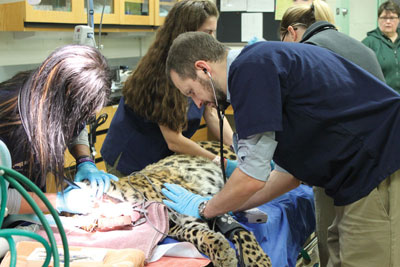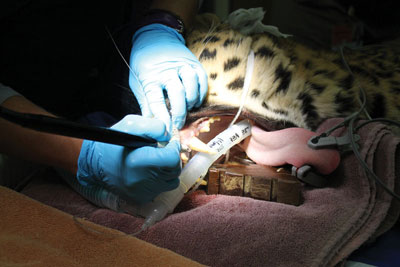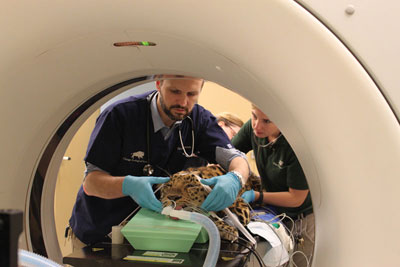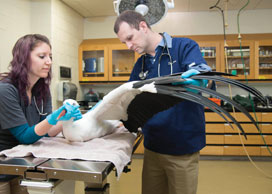Zoo veterinarians, behind the scenes and in the field

A flurry of activity surrounded Kasha, an Amur leopard, as he lay, intubated and anesthetized, on an examining table.
A veterinary technician cleaned the big cat’s teeth, including his long canines. Two veterinarians in training programs took a blood sample from a hind limb. Dr. Mike Adkesson listened to the leopard’s heart.
Kasha was undergoing a routine full work-up at the Brookfield Zoo in Brookfield, Illinois, a suburb of Chicago. The zoo has seven veterinarians on staff: Dr. Adkesson, vice president of clinical medicine for the Chicago Zoological Society, which operates the zoo; three other clinical veterinarians who are specialists in zoological medicine, one also an anesthesiologist; a clinical resident; a post-residency anesthesiology fellow; and a radiologist.
Although the American Association of Zoo Veterinarians dates to 1946, and the American College of Zoological Medicine to 1983, having multiple veterinarians on staff was not common at major U.S. zoos until recently.
"We’ve seen tremendous advancement in the quality and the standards of care that we’re able to provide, compared to where zoo medicine was 20 or 30 years ago," Dr. Adkesson said.
Zoo veterinarians say their day-to-day work can encompass thousands of individual animals and a multitude of species of mammals, birds, reptiles, amphibians, and fish. They love the challenge and the diversity.
They see the animals as ambassadors for conservation. Zoo veterinarians also participate directly in conservation projects ranging from breeding programs to a variety of fieldwork, with some veterinarians at zoos focusing on wildlife in the wild.
Dr. Deem, Saint Louis Zoo
Dr. Sharon L. Deem grew up next to the National Zoo in Washington, D.C. She went there every weekend and got hooked on conservation. Now she is director of the Saint Louis Zoo Institute for Conservation Medicine and president of the ACZM.
When Dr. Deem graduated from the Virginia-Maryland College of Veterinary Medicine in 1988, there were not a lot of zoo and wildlife veterinarians, but the occupations were growing. She earned a doctoral degree from the University of Florida in epidemiology, looking at tick-borne diseases in Africa and at the interface of domestic animals and wildlife. She went on to a residency in zoological medicine at the university and has been working for zoos ever since.
She has been a clinical zoo veterinarian, and she has been a field veterinarian working on free-living wildlife from forest elephants to sea turtles. After joining the Saint Louis Zoo, she lived with her family on the Galapagos Islands, working on avian health. Then she started the Institute for Conservation Medicine.
Dr. Deem is among the many veterinarians in zoological medicine who think of zoo animals as ambassadors. She said, "Zoos have increasingly understood that to keep animals in collections healthy, we need excellent veterinary care." Many zoos are adding more veterinarians to provide better care, beyond simply darting animals for hands-on treatments or to administer vaccinations. She said collection animals today at zoos accredited by the Association of Zoos and Aquariums get full-spectrum health care.
The ACZM started out with very few diplomates but now has surpassed 200. According to the mission statement, "Zoological medicine is a discipline that integrates principles of ecology, conservation, and veterinary medicine and applies them to wild animals within natural and artificial environments. The American College of Zoological Medicine is dedicated to excellence in furthering the health and well being of captive and free-ranging wild animals."
Dr. Deem said the body of literature in zoological medicine has grown exponentially in the past decade or so. Still, veterinarians at zoos tend to be general practitioners, providing neonatal to geriatric medicine for poison dart frogs to elephants to beluga whales.
"There are many clinical zoo veterinarians that may have one field project in which they contribute to free-living population conservation," Dr. Deem said. "Someone like myself and increasingly other vets have developed programs in which we focus more on population-level health care and not just the individual animal in our collections. In these positions, we direct much of our energies at understanding the impact of diseases on free-living wildlife populations, working to ensure healthy animals at the species level."

Dr. Adkesson, Brookfield Zoo
At Brookfield Zoo, another flurry of activity surrounded Kasha the leopard as he was being prepared to go into the CT scanner. Dr. Adkesson and the zoo’s radiologist, Dr. Marina Ivančić, checked on Kasha’s positioning.

Then everyone left the room, with Drs. Adkesson and Ivančić sitting at computers outside a window into the room. After running the first scan, the veterinarians decided to inject a contrast agent to obtain reference images of a healthy leopard. There are few CT reference images for many species, and Brookfield is one of three zoos in North America to have an in-house CT scanner.
"Diagnosis: handsome," Dr. Ivančić said of Kasha, in jest. She is the only full-time, board-certified veterinary radiologist working at a zoo or aquarium in the United States, and she provides a consulting service for other zoos (see story).
Dr. Adkesson, AAZV president-elect, got hooked early on zoo and conservation medicine, like Dr. Deem. He worked at the Scovill Zoo in Decatur, Illinois, throughout high school and college. In veterinary school, he did rotations at zoos. He earned his veterinary degree from the University of Illinois in 2004, completed a small animal internship and a residency in zoological medicine, then joined Brookfield.

"It’s incredibly fulfilling work. I think that’s what attracts most of us to the specialty and keeps us engaged. And it’s ever-changing, too," he said. "It’s a field still full of questions and unknowns that can spark your interest and then allow you to put together a research opportunity to investigate. The outcome to many of these questions can have a true immediate impact on the health and welfare of a species in a zoo setting."
Dr. Adkesson oversees the veterinary staff, daily hospital operations, and health care of more than 3,000 animals at the zoo. He participates in a conservation program in Peru for Humboldt penguins, fur seals, and sea lions. The Chicago Zoological Society has two staff members there, and Dr. Adkesson goes down twice a year for fieldwork.
At the zoo, day-to-day duties include tending to the baby reindeer born the previous day as well as tending to animals that have lived long enough with good care to develop conditions ranging from degenerative arthritis to renal failure and cardiac disease.

Giraffes and penguins have always been among Dr. Adkesson’s favorite species, while sea lions have more recently joined the list. He has grown fond of individual animals, including Nora the gorilla, Pepe the penguin, and Arie the sea lion.
Brookfield Zoo hosts veterinary students for four- to eight-week rotations, along with providing a residency training program. Dr. Adkesson finds fulfillment in training individuals who go on to careers in zoo medicine.
The AAZV has grown to about 1,000 members, from full-time zoo veterinarians to private practitioners who work at zoos part time. According to the mission statement, "The mission of the American Association of Zoo Veterinarians is to optimize the health, welfare, and conservation of zoo animals and wildlife through education, scientific study, collaboration and advocacy."
Dr. Larsen, Denver Zoo
Dr. Scott Larsen, AAZV president and vice president for veterinary medicine at the Denver Zoo, stumbled into the idea of veterinary medicine as a potential career during his undergraduate studies, as an avenue for his interest in biology and the diversity of biology. He volunteered and then worked at the Hogle Zoo in Salt Lake City and realized that zoo medicine was a career option.
After earning his veterinary degree in 1995 from Colorado State University, Dr. Larsen completed a large animal internship, then took zoo and wildlife training programs. He was on the faculty at the University of California-Davis, concurrently working at the Sacramento Zoo, before joining the Denver Zoo.
"I’ve always had a strong interest in and dedication to wildlife and conservation, but I also really like having a career that is very diverse in what I do and very hands-on, and zoological medicine is an amazing combination of those things," he said.
Dr. Larsen leads the Denver Zoo’s veterinary and nutrition departments and is a part-time clinician. The veterinary team’s patients are more than 4,000 animals ranging from catfish to elephants to lorikeets. The veterinarians each have affinities for certain taxa of animals and expertise within certain areas of zoological medicine, with one of Dr. Larsen’s passions being in the area of anesthesia.
The veterinary team also provides support for the zoo’s conservation biology program, which includes a long-standing field project in Mongolia to protect wildlife such as gazelles, sheep, and vultures.
Dr. Larsen said AAZV members rely heavily on each other for sharing information, whether a new clinical treatment or ideas for designing a new hospital. He said, "We’re discovering new things every day. We’re adapting and figuring out something new in terms of treatments or a device that might work." Among other recent examples, the Denver Zoo has developed fiberglass caps to protect the tusks of a playful elephant and a treatment plan for a king cobra with skin cancer.
Among the challenges for zoo veterinarians is managing captive breeding programs to create sustainable populations within the zoo community and sometimes to release animals to the wild. Another challenge is managing infectious diseases, including preparing for outside threats such as avian influenza, plague, and rabies.
Dr. Larsen said people who are dedicated and flexible can make it as zoo veterinarians. There are more jobs than there were 10 to 20 years ago, although restrictions by geography, family, or finances can prove difficult. He said these facts don’t seem to have reduced the number of veterinary students interested in zoological medicine.
Back at Brookfield
After Kasha’s work-up, Dr. Adkesson gave a tour of the hospital at Brookfield Zoo. Near his office are laboratories for clinical pathology and the zoo’s environmental quality monitoring. Almost all the lab work is done in-house, except for some disease testing. Across the hall is a bank of cryopreserved blood and tissue samples.
In the imaging suite, Dr. Adkesson explained that much of the equipment can be taken to the exhibits of big animals. He showed off the surgical suite, intensive care unit, and main holding area. For hoofstock, there are large holding stalls and two padded stalls for induction of anesthesia. Any new animals stay for 30 days in a quarantine area.
Outside the walls of the hospital, visitors walked around the exhibits despite rainy weather, with the free-roaming peacocks calling plaintively.
Even as zoos continue as public entertainment, Dr. Adkesson said their role has pivoted to conservation. He said, "That is really where all of our focus today lies. Our mission today is to inspire conservation leadership for animals and nature."
Drs. Adkesson, Deem, and Larsen share more of their thoughts on the relevance of zoos within society today in "Role of zoos is conservation, zoo veterinarians say" (see story).
Related JAVMA content:
Brookfield Zoo invests in imaging with full-time radiologist (July 15, 2017)
Role of zoos is conservation, zoo veterinarians say (July 15, 2017)
Is it ethical to keep animals in zoos? (Dec. 1, 2002)
